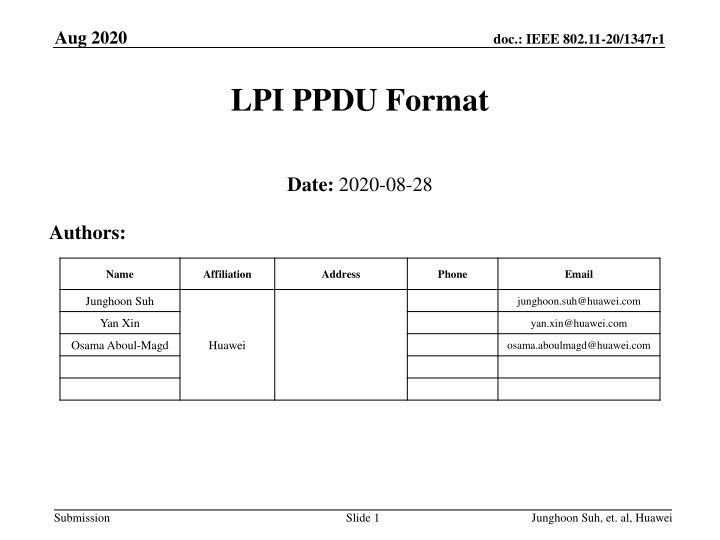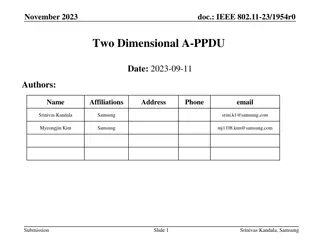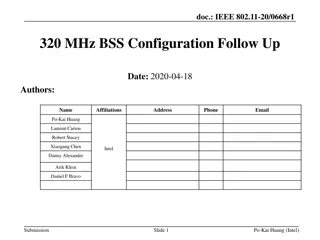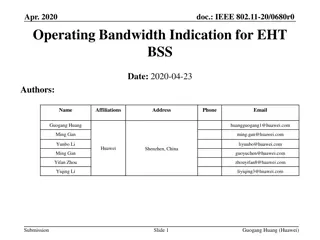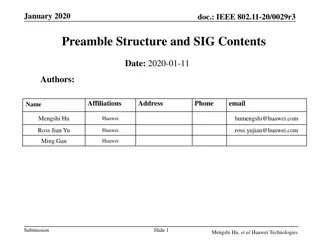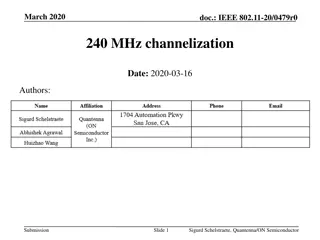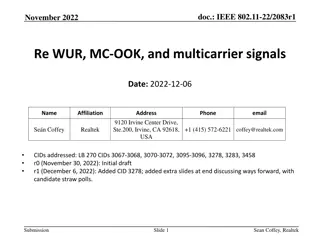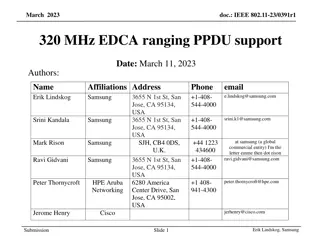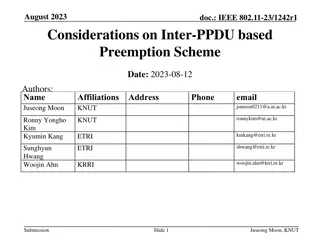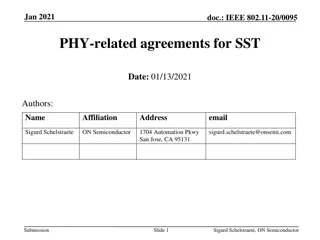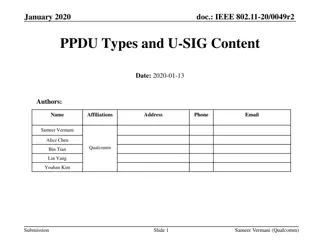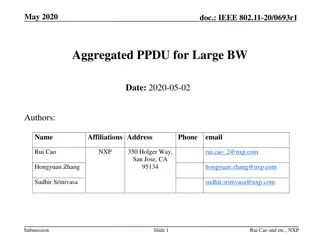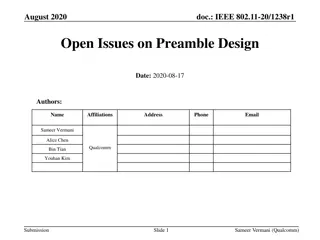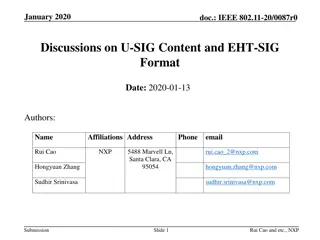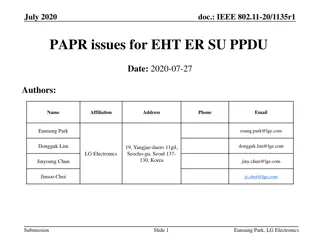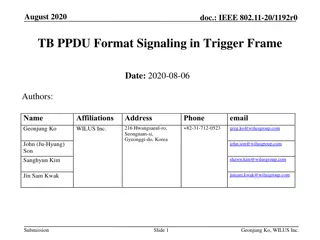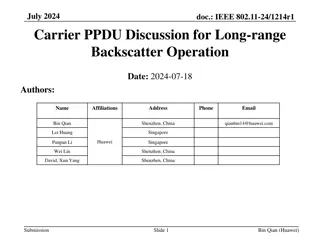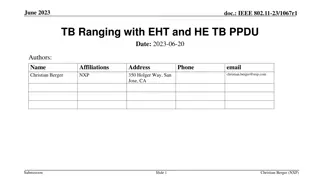Proposed 80 MHz EHT LPI PPDU Format for IEEE 802.11-20/1347r1
The document presents the proposed LPI PPDU format for IEEE 802.11-20/1347r1, focusing on enhancing the robustness of the preamble and payload in non-OFDMA frames. The format includes repetitions of U-SIG and E-SIG symbols, optimizing DCM gain for improved performance. Simulation results show advantages in detection SNR range and robustness compared to existing methods.
Download Presentation

Please find below an Image/Link to download the presentation.
The content on the website is provided AS IS for your information and personal use only. It may not be sold, licensed, or shared on other websites without obtaining consent from the author.If you encounter any issues during the download, it is possible that the publisher has removed the file from their server.
You are allowed to download the files provided on this website for personal or commercial use, subject to the condition that they are used lawfully. All files are the property of their respective owners.
The content on the website is provided AS IS for your information and personal use only. It may not be sold, licensed, or shared on other websites without obtaining consent from the author.
E N D
Presentation Transcript
Aug 2020 doc.: IEEE 802.11-20/1347r1 LPI PPDU Format Date: 2020-08-28 Authors: Name Affiliation Address Phone Email Junghoon Suh junghoon.suh@huawei.com Yan Xin yan.xin@huawei.com Osama Aboul-Magd Huawei osama.aboulmagd@huawei.com Submission Slide 1 Junghoon Suh, et. al, Huawei
Aug 2020 doc.: IEEE 802.11-20/1347r1 Background DUP mode is defined for non-punctured 80MHz, 160MHz and 320MHz PPDUs transmitted to a single user, and limited to {MCS0+DCM, Nss=1} [1] Ref. [1] mainly targets the Low Power Indoor (LPI) PPDU with the range extension The DUP mode is defined for the payload, which may result in more robust design for the payload than for the preamble We propose an LPI PPDU Format to make the preamble more robust 2 Symbol U-SIG is more than enough for PHY header in LPI PPDU Preamble without E-SIG is proposed Submission Slide 2 Junghoon Suh, et. al, Huawei
Aug 2020 doc.: IEEE 802.11-20/1347r1 80 MHz LPI PPDU from [2] Legacy preamble U-SIG EHT -SIG Legacy preamble U-SIG EHT_ SIG EHT -LTF LPI LR Payload EHT -STF Legacy preamble U-SIG EHT -SIG Legacy preamble U-SIG EHT -SIG LPI PPDU is sent to a single user, and it is a non-OFDMA frame U-SIG (2 symbols) and E-SIG (1 symbol) are repeated 4 times across 80 MHz, with MCS 0 40 MHz Payload is repeated twice across 80 MHz with MCS0 + DCM Submission Slide 3 Junghoon Suh, et. al, Huawei
Aug 2020 doc.: IEEE 802.11-20/1347r1 Performance of DCM+MCS0 [3] 5 dB When the baseline is 20 MHz MCS0, U-SIG achieves 6 dB gain with 4 repetitions While Payload achieves 3 dB gain with 2 repetitions and 5 dB gains with DCM Payload is more robust than U-SIG, based on an Intuitive analysis Submission Slide 4 Junghoon Suh, et. al, Huawei
Aug 2020 doc.: IEEE 802.11-20/1347r1 Performance check by Simulation Indication of LPI PPDU needs to take place before the U-SIG decoding in order to apply the 4x combining to decoding the U-SIG DCM gain is optimized with the smaller RU size, higher MCS, and with the shorter packet size Detection SNR range (10% PER) for 80 MHz is about 6 dB higher than the 20 MHz only detection Slide 5 Submission Junghoon Suh, et. al, Huawei
Aug 2020 doc.: IEEE 802.11-20/1347r1 Proposed 80 MHz EHT LPI PPDU L-Preamble / RL-SIG RU-SIG U-SIG L-Preamble / RL-SIG RU-SIG U-SIG EHT-STF/LTF and Payload L-Preamble / RL-SIG U-SIG RU-SIG L-Preamble / RL-SIG U-SIG RU-SIG We propose to repeat U-SIG once in time domain just like RL-SIG, and call it RU-SIG LPI PPDU is auto-detected with the correlation check between U-SIG and RU-SIG PPDU type for LPI is not needed to explicitly indicate The parameters such as Puncturing patterns, PPDU type, EHT-SIG MCS, Payload MCS, Number of EHT-SIG Symbols, EHT-SIG Compression, N_STS bits are not needed for LPI 2 Symbol U-SIG seems good enough for the preamble efficiency. Overflow extra EHT-SIG symbol is not necessary Auto-detection is good for non-destination STAs to discern LPI frame from the regular frames such as EHT MU PPDU and EHT ER SU type of PPDU Submission Slide 6 Junghoon Suh, et. al, Huawei
Aug 2020 doc.: IEEE 802.11-20/1347r1 Category Version identifier U-SIG contents analysis for LPI PPDU Subfield Bits 3 1 6 7 3 Field UL/DL BSS color TXOP PPDU BW Punctured channel indication(global for non- OFDMA) Reserved PPDU format Reserved EHT-SIG MCS Number of EHT-SIG symbols EHT-SIG Compression CRC in U-SIG Tail in U-SIG Total # of Bits in U-SIG Spatial reuse GI+LTF size Number of EHT-LTF symbols and midamble periodicity Version Independent 5 1 1 6 2 5 2 4 6 U-SIG Version Dependent U-SIG & E-SIG contents are given in [4] The subfields in blue color are not necessary for LPI PPDU, while those in red color may have different bit size We propose the U-SIG contents for LPI PPDU in the next slide CRC & Tail 52 4 3 3 Version Dependent (U- SIG Overflow) Doppler 1 EHT-SIG Pre-FEC padding 2 LDPC extra symbol segment Reserved PE disambiguity Total # of Overflow Bits 1 2 1 17 Submission Slide 7 Junghoon Suh, et. al, Huawei
Aug 2020 doc.: IEEE 802.11-20/1347r1 Proposed U-SIG contents for LPI PPDU Field Category Subfield Bits Version Independent Version identifier 3 UL/DL 1 BSS color 8 TXOP 7 PPDU BW 3 Version Dependent Spatial Reuse 4 GI+LTF size 3 U-SIG Doppler & Midamble periodicity 2 Pre-FEC Padding 2 LDPC Extra symbol segment 1 PE disambiguity 1 Reserved 7 CRC & Tail CRC 4 Tail 6 Total bits in U-SIG 52 Submission Slide 8 Junghoon Suh, et. al, Huawei
Aug 2020 doc.: IEEE 802.11-20/1347r1 Summary We proposed to repeat U-SIG to strengthen the Preamble detection Auto-detection using the correlation between U-SIG and RU-SIG can indicate LPI PPDU. No need to introduce an additional entry in PPDU Type field Overflow U-SIG into an EHT-SIG is not necessary Submission Slide 9 Junghoon Suh, et. al, Huawei
Aug 2020 doc.: IEEE 802.11-20/1347r1 SP1 Do you agree to introduce RU-SIG as in slide 5 to the EHT LPI PPDU for the purpose of auto-detection and robust preamble detection? Submission Slide 10 Junghoon Suh, et. al, Huawei
Aug 2020 doc.: IEEE 802.11-20/1347r1 SP2 Do you agree to remove an overflow U-SIG, that is, one symbol EHT-SIG in LPI PPDU? Submission Slide 11 Junghoon Suh, et. al, Huawei
Aug 2020 doc.: IEEE 802.11-20/1347r1 Reference [1] Ron Porat, 6GHz LPI Range Extension 11-20/965r3, IEEE TGbe [2] Jianhan Liu, et. al., DCM for range extension in 6GHz LPI , 11-20/986r1, IEEE TGbe [3] Jianhan Liu, et. al., On Modulation of MCS0 DCM and DCM Capability , 11-16/655r1, IEEE TGax [4] Sameer Vermani, Open Issues on Preamble Design , 11- 20/1238r0, IEEE TGbe Submission Slide 12 Junghoon Suh, et. al, Huawei
